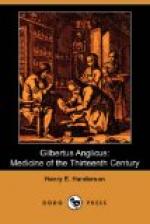Physiognomy, a favorite theme with our author, appears again in a considerable chapter on the physiognomy of the nose, mouth, face and the teeth.
“He who laughs frequently is kind and genial in all things and is not worried over trifles.”
“He who laughs rarely is contrary and critical.”
“He who has large ears is stolid and long-lived.”
“He who has a large mouth is gluttonous and daring.”
“He whose teeth are defective and small is weak in his whole body.”
“He whose canine teeth are long and straight is a glutton and a rascal.”
The department of genito-urinary diseases is introduced by a long chapter entitled “De approximeron,” a formidable Latin word defined by Gilbert as sexual impotence. An elaborate discussion of the physiology of generation and the phenomena of impotence is followed by a collection of remedies for the condition, of which the best that can be said is that they are probably no less effective than most of the modern drugs recommended for the same purpose. Concerning a function over which so many fond superstitions still linger in the public mind we may, perhaps, charitably forgive Gilbert for the introduction of an empirical remedy for sterility, which, he assures us, he has often tried and with invariable success, and which enjoys the double advantage of applicability to either sex.
“Let a man, twenty years of age or more, before the third hour of the vigil of St. John the Baptist, pull up by the roots a specimen of consolida major (comfrey) and another of consolida minor (healall), repeating thrice the Lord’s prayer (oratio dominica). Let him speak to no one while either going or returning, say nothing whatever, but in deep silence let him extract the juice from the herbs and with this juice write on as many cards as may be required the following charm:
“Dixit dominus crescite. [symbol: dagger]. Uthihoth. [symbol: dagger]. multiplicamini. [symbol: dagger]. thahechay. [symbol: dagger]. et replete terram. [symbol: dagger]. amath.
“If a man wears about his neck a card inscribed with these identical words written in this juice, he will beget a male. Conversely, if a woman, she will conceive a female” (f. 287b).
Gilbert, however, cautions the bearer of this potent charm of the possible dangers of satyriasis incurred thereby, and offers suitable remedies for so alarming a condition.
Chapters on satyriasis, gomorrhea (gonorrhea in its etymological sense, seminal emissions), with a third entitled “De pustulis et *_apostematibus virgae_” complete this department of medical art. The last chapter recognizes the venereal origin of the pustules and ulcers discussed, but furnishes no direct evidence of Gilbert’s belief in the existence of a specific venereal poison.
While Gilbert is very scrupulous in his examination of the gross appearances of the urine in most diseases, his discussion of the diseases of the kidneys and bladder includes only pain in the kidneys, abscess of the kidneys, renal and vesical calculus, hematuria, incontinence of urine, dysuria and strangury.




